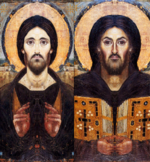Until the early 21st century (with few exceptions), mainstream Jewish and Christian scholars paid little attention to the Toledot Yeshu. The opinion of noted advocate of Christian-Jewish reconciliation, Father Edward H. Flannery, is representative:
This scurrilous fable of the life of Jesus is a medieval work, probably written down in the tenth century. [...] Though its contents enjoyed a certain currency in the oral traditions of the Jewish masses, it was almost totally ignored by official or scholarly Judaism. Antisemites have not failed to employ it as an illustration of the blasphemous character of the Synagogue.
A recent study reports that more than 100 manuscripts of the Toledot exist, almost all of them late medieval (
the oldest manuscript being from the 11th century)"
. . .
Some scholars assert that the source material is no earlier than the 6th century, and the compilation no earlier than the 9th century.
. . .
For example, the "nativity" account in chapter 1 of the Strassburg version of the Toledot is derived from Kallah, a purported Talmudic tractate whose provenance is so uncertain that it did not appear in print until 1864. Moreover, the anecdote in Kallah may not refer to Jesus at all.
. . .
Jews apparently polemicised actively against the new Christian religion, as can be inferred from the 2nd century Christian writer Justin Martyr's Dialogue with Trypho, a fictional dialogue between a Christian and a Jew. In chapter 17 Justin claims that the Jews had sent out "chosen men" throughout the Roman Empire to polemicize against Christianity, calling it a "godless heresy".
. . .
Long unknown to Christians, the Toledot was first translated into Latin by Ramón Martí, a Dominican friar, toward the end of the 13th century.
. . .
(Klausner notes that the Toledot scarcely ever denies Gospel miracles, but merely changes good to evil.)
Judas Iscariot, the hero of the tale, learns the Divine Name as well, and Jesus and Judas fly through the sky engaged in aerial combat, with Judas victorious. The now powerless Jesus is arrested and put to death by being hung upon a carob tree, and buried.
. . .
[Et cetera, et cetera]

) are active in Rome before Paul ever gets there. (What's the evidence Peter made his way to Rome? I am not a historian.)

